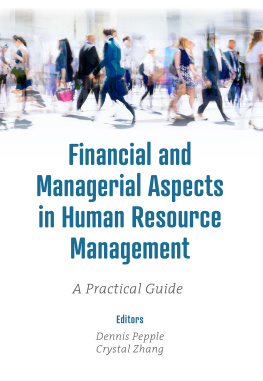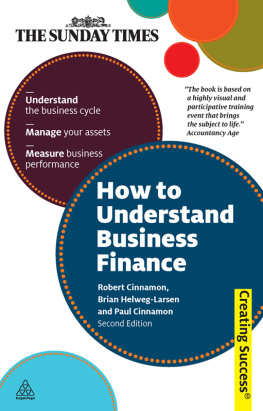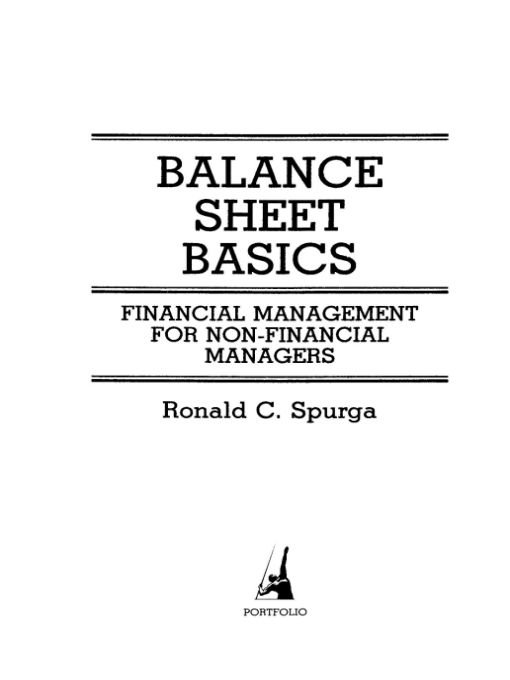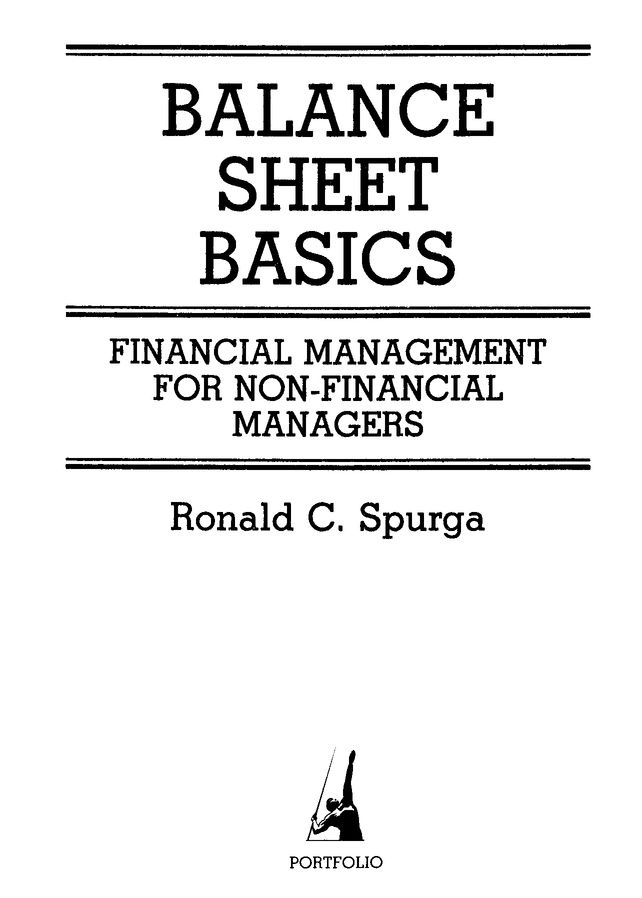Table of Contents
PORTFOLIO
BALANCE SHEET BASICS
Ronald C. Spurga, CFP, is a Certified Financial Planner and a Vice President of ABN AMRO Bank, which has $100 billion of assets under management. Mr. Spurga has also worked as an investment banker and financial analyst on Wall Street. He is a graduate of the Amos Tuck School of Business Administration at Dartmouth College. Mr. Spurga has an MBA in finance, and he has taught economics at Rutgers University, Fordham University, and New York University. He has written a bestselling how-to-invest primer entitled A Practical Guidetothe Commodities Markets and he appears as a commentator on CNBC.
For Marie,
Kathleen,
Danny,
Kyle,
and
Jennifer,
my
extraordinary
family
Between the idea And the reality ... Falls the shadow ...
T.S. Eliot, The Hollow Men
Preface
Todays managers are being called upon to make more financial decisions than at any time in the past. Hardly a day goes by without managers being called upon to speed up receivable collections, shrink down inventory levels or arrange bank financing. Since most managers began their careers in non-financial areas, it is only natural that they find these new demands for financial decisions somewhat bewildering.
The purpose of this book is to provide the non-financial manager with a basic understanding of how financial information flows are assembled to determine the operating health of the business enterprise.
In
Balance Sheet Basics, you will be able to develop your financial skills by:
Learning the basic obligations of the financial manager.
Discovering the techniques for analyzing financial statements.
Interpreting the profit-and-Ioss statement.
Measuring the firms liquidity.
Using business ratios to measure the economic health of the business enterprise.
Balance Sheet Basics avoids technical jargon and provides the diligent reader with a user-friendly financial manual.
For example, in Chapter 2, you will be shown how to develop the profit-and-loss statement of a small manufacturer. You will also learn to value the raw materials, direct labor, and manufacturing overhead accounts in order to interpret a profit-and-loss statement. Then you will be given a ratio worksheet with which to compare the current situation in your firm against your competition.
Chapter 4 shows you how to take control in financial management. Success or failure relates to how financial management manages. Measure yourself against the characteristics of proven achievers.
Chapter 8 presents a case history of ratio analysis in action. Discover for yourself the famous case method of financial analysis used for a generation at the Harvard Business School. And the remaining chapters show you how and when to put the case method into practice to turn yourself into a financial professional.
WHAT IS FINANCIAL MANAGEMENT?
It takes money to make money. This maxim is a simple way of saying that a business must have financial resources if it is to operate profitably. If you are in retailing or wholesaling, you must keep a stock of goods on hand to sell. You need to extend credit to customers. A bank balance must be maintained for expenses such as paying suppliers and meeting payrolls. Unless you rent your place of business, funds are necessary for investments in land and buildings. If you are a manufacturer, funds are also required for equipment and machinery, for raw materials and supplies, for stocks of goods in the process of manufacture, for finished goods ready for sale.
But having money does not guarantee making moneythat is, making a profit. You not only have to have money; you have to use it well. That is why financial management is important.
Financial management includes the following functions:
Seeing that the assets of the business are used in such a way as to bring the highest possible return on the money invested.
Evaluating the need for new assets.
Obtaining funds to finance asset additions.
Managing both old and new assets so that each contributes its full share toward the profitable operation of the business.
Repaying borrowed funds from profits those funds have generated.
GETTING THE FINANCIAL RESOURCES YOU NEED
Your most important task as financial manager is to find sources of funds to offset the companys uses of funds. When a need for funds arise:
You can increase liabilities and/or equity to match the increases in assets.
Or you can reduce the investment in some existing asset so as to hold down the total investment in assets.
Lets assume, for example, that your business, in order to keep or expand its sales volume, needs to extend more credit to customers for longer periods of time. In other words, the investment in receivables (an asset) must be increased. You may or may not be able to increase your borrowings. That will depend, perhaps, on whether you can convince your banker that the move is a wise one and that the companys financial position is strong enough to warrant a loan. And you may or may not be able to get more equity capital to finance the receivables increase. You might decide, thereforeor be forcedto squeeze down other assets, such as bank balances or inventories, to provide the needed funds. Your job as financial manager is to decide which of these sources can andeven more important in many instanceswhich one should be tapped for the financial resources you need.
MAKING A PROFITYOUR BASIC OBLIGATION
A primary reason for owning and operating your own business is to make the highest possible profit for yourself. You also have responsibilities to employees, to customers, to members of the community whose lives your company influences and these responsibilities are important. But it is you who have taken the risk of contributing capital. Your basic goal is to take care of this capital and use it as profitably as possible.
It is important, therefore, for you to have at your command a useful measure of business performance that emphasizes financial returns. There are several methods of measuring profitability, but one in particularreturn on investmentis especially useful.
MANAGING ASSETS
One of your most important duties as financial manager is to keep the assets of the business working hard and productively. It is easy for a small business to slip into the practice of having larger inventories, bank balances, and other investments than are really needed. Bigger is often equated with better. The sales manager wants larger inventories, more lines of finished stocks, more liberal credit terms. These added investments will improve his or her sales efforts. The production manager wants newer and faster machines and tools, larger stocks of raw materials and supplies. These investments enable him to cut costs and meet delivery dates. The financial manager wants larger cash balances to make his or her job easier. Office management needs new equipment. Often it seems that the opportunities to spend money are unlimited!
The aim of asset management is to make certain that new or increased assets pay their way. The added profits these new assets bring in should total more than the cost of the resources involved. The return-on-investment measure mentioned above can be used to show the expected effect on profits of an investment you may be thinking about making. Thus, it is a useful tool in judging and comparing various investment opportunities.









